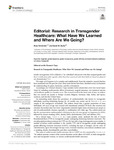| dc.contributor.author | Fernández, Rosa | |
| dc.contributor.author | Burke, Sarah M. | |
| dc.date.accessioned | 2022-04-26T10:17:27Z | |
| dc.date.available | 2022-04-26T10:17:27Z | |
| dc.date.issued | 2022 | |
| dc.identifier.citation | Fernández R and Burke SM (2022) Editorial: Research in Transgender Healthcare: What Have We Learned and Where Are We Going? Front. Endocrinol. 12:832866. doi: 10.3389/fendo.2021.832866 | es_ES |
| dc.identifier.uri | http://hdl.handle.net/2183/30536 | |
| dc.description | This article was submitted to Neuroendocrine Science, a section of the journal Frontiers in Endocrinology | es_ES |
| dc.description | This article is part of the research topic: Research in Transgender Healthcare: What Have We Learned and Where are We Going? | es_ES |
| dc.description.abstract | [Abstract] Gender incongruence (GI) is defined as “an individual’s discontent with their assigned gender and their identification with a gender other than that associated with their birth sex based on physical sex characteristics”.
The origin of GI appears to be complex and multifactorial. From the extensive research that has been conducted over the past few years, three main factors have been identified as key mechanisms for understanding GI: genes, hormones, and the environment.
Accordingly, our Frontiers Research Topic includes twelve articles that cover very varied topics about GI, including cardiovascular effects of treatment, surgical outcomes, new treatment options and healthcare quality in a broader sense. This research involved the hard work of sixty-six authors that was carried out mainly in Europe (Austria, Belgium, Germany, Italy, Serbia, and Spain), Australia, and also the United States. | es_ES |
| dc.description.sponsorship | This study was supported by the Spanish Ministry of Science and Innovation Grant No. PGC2018-094919-B-C22 | es_ES |
| dc.language.iso | eng | es_ES |
| dc.relation | info:eu-repo/grantAgreement/AEI/Plan Estatal de Investigación Científica y Técnica y de Innovación 2017-2020/PGC2018-094919-B-C22/ES/ESTUDIO GENETICO Y EPIGENETICO DEL TRATAMIENTO HORMONAL CRUZADO EN UNA POBLACION TRANSEXUAL: UN ESTUDIO LONGITUDINAL/ | es_ES |
| dc.relation.uri | https://doi.org/10.3389/fendo.2021.832866 | es_ES |
| dc.rights | Atribución 4.0 Internacional | es_ES |
| dc.rights.uri | http://creativecommons.org/licenses/by/4.0/ | * |
| dc.subject | Cisgender | es_ES |
| dc.subject | Gender dysphoria | es_ES |
| dc.subject | Gender incongruence | es_ES |
| dc.subject | Gender-affirming hormonal treatment | es_ES |
| dc.subject | Healthcare | es_ES |
| dc.subject | Non-binary | es_ES |
| dc.subject | Transgender | es_ES |
| dc.title | Editorial: Research in Transgender Healthcare: What Have We Learned and Where Are We Going? | es_ES |
| dc.type | info:eu-repo/semantics/article | es_ES |
| dc.rights.access | info:eu-repo/semantics/openAccess | es_ES |
| UDC.journalTitle | Frontiers in Endocrinology | es_ES |
| UDC.volume | 12 | es_ES |
| UDC.issue | 832866 | es_ES |
| dc.identifier.doi | 10.3389/fendo.2021.832866 | |






